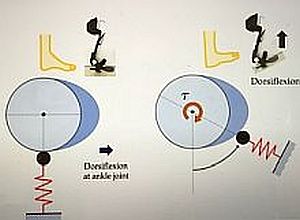A research group has developed a new, lightweight and motor-less device that can be easily attached to an ankle support device – otherwise known as an ankle foot orthosis (AFO). The new device will aid stroke patients in their rehabilitation, improving their walking and preventing falls.
Stroke patients often suffer from motor paralysis as a result of damage to the brain, significantly affecting their walking. Gaits disorder, as it is otherwise known, results in restrictive disabilities and increased health care costs. Rehabilitation is key to stroke recovery. Yet around 40% of stroke patients struggle to function properly due to problems with their walking abilities.
One part of the problem is due to insufficient knee bending, or knee flexion, during walking. This leads to lower toe clearance – the distance between the toe and the ground when the foot swings forward – and causes patients to fall. To overcome this, patients frequently hip hike on the affected side, a process by which the patient elevates one side of their hip to move their foot. This makes patients walking movement awkward and decreases their motivation in rehabilitation.
Comprised of Professor Shin-Ichi Izumi and Associate Professor Dai Owaki from Tohoku University's Graduate Schools of Medicine and Graduate School of Engineering along with Takeo Nozaki and Dr Ken-ichiro Fukushi from NEC Corporation, the research group created a device which gives the ankle greater push-off power using a spring-cam mechanism. The elliptical shaped cam rotates in conjunction with the AFO, pushing against the spring. The resultant reactive force from the spring generates significant ankle push-off power.
The research group conducted clinical experiments on 11 stroke patients with paralysis on one side of the body, demonstrating that the device generated greater ankle power. This in turn aided knee flexion whilst the affected foot was in the swing phase of walking – when the foot is raised in the air.
"Our device will pave the way for positive impacts on the rehabilitation of stroke patients," said Owaki. He adds, "It will prevent falls and make patients feel more confident in their walking abilities."
Abstract
Background: Ankle–foot orthoses with plantarflexion resistance (AFO-Ps) improve knee flexion in the stance phase on the paretic side in patients with hemiparesis. However, AFO-Ps decrease ankle power generation in the late stance phase and do not improve the knee flexion in the swing phase based on insufficient push-off at the late stance, resulting in lower toe clearance.
Research question: This study sought to investigate the effect of an AFO with dorsiflexion resistance, which was implemented by our developed device with spring–cam mechanism attached to the AFO-P (Gait Solution; Pacific Supply Co., Ltd., Japan), on kinetics and kinematics in the lower limb during gait in patients with hemiparesis.
Methods: Eleven patients with hemiparesis due to stroke walked on a 7-m walkway at a self-selected comfortable pace in the following conditions: (a) walking using the AFO-P with the proposed device with a spring–cam mechanism (AFO-PCAM), (b) walking using the AFO-P without our device (AFO-P), and (c) walking using no device (barefoot condition). Gait kinematics and kinetics were collected using a three-dimensional motion analysis system and four ground-reaction force plates. Changes in all parameters from the barefoot to AFO-PCAM and AFO-P conditions were compared using the Wilcoxon signed-rank test.
Results: In the AFO-PCAM condition, decrease in the maximum ankle power generation in the late-stance phase was significantly smaller than that in the AFO-P condition (p = 0.041). We noted a significant higher change in knee flexion in the paretic swing phase in the AFO-PCAM condition relative to that in the AFO-P condition (p = 0.016). The effect size for the comparisons of change was large (r ≧ 0.5).
Significance: Our device facilitated the realization of the ankle plantarflexion power in the late-stance phase because of dorsiflexion resistance, increasing the knee flexion angle during the swing phase.
Authors
Yusuke Sekiguchi, Dai Owaki, Keita Hondaa, Kenichiro Fukushi, Noriyoshi Hiroi, Takeo Nozaki, Shin-ichi Izumi
[link url="http://www.tohoku.ac.jp/en/press/putting_the_spring_back_into_stroke_patients_steps.html"]Tohoku University material[/link]
[link url="https://www.sciencedirect.com/science/article/abs/pii/S0966636220302307?via%3Dihub"]Gait & Posture abstract[/link]

